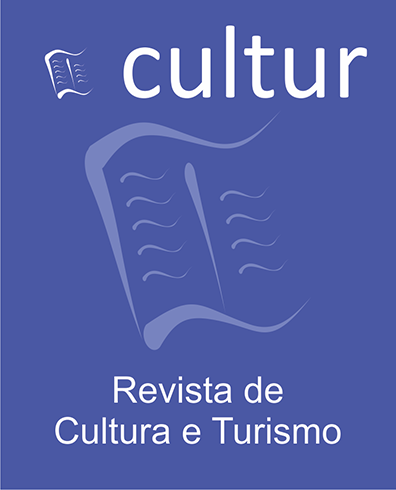CRUISE TOURISM AS FACTOR OF SOCIAL EXCLUSION ON COZUMEL ISLAND´S RESIDENTS’ PERCEPTION
Resumo
Cozumel is an island that has been developed as a tourist destination and during the last 15 years tourism activity has been oriented to cruise tourism, which is the main driver of the island economy. Most of the cruise lines with operations in the Caribbean have arrivals to the island, and therefore it is a case that highly represents the way how community develops and integrates with the local action. Nevertheless there is evidence that, even though the rapid development and the international flow, cruise tourism brings little benefit to local communities in general and it might even promote social exclusion. The paper analyzes Cozumel residents’ perception about the way cruise tourism is a driver of social exclusion, understood from the conceptual frame developed by Levitas et. al. (2007) through a case study at Cozumel, Mexico, which was carried out using a two-stage mixed method design (quantitative and qualitative). Findings lead to confirm that, at least for the case study, cruise tourism produces the perception of an increase on the factors that drive social exclusion. Main findings and future research lines are presented.Downloads
Referências
Arroyo, L., & Gutierrez, E. (2007). El empleo en el sector hotelero de Cozumel y su impacto en la comunidad. Teoría Y Praxis, 3(2007), 65–76. Retrieved from http://dialnet.unirioja.es/servlet/articulo?codigo=2929601
Baldacchino, G., & Kelman, I. (2014). Critiquing the pursuit of island sustainability. Shima, 8(2), 1–21.
Baloglu, S., & McCleary, K. (1999). US international pleasure travelers’ images of four Mediterranean destinations: A comparison of visitors and nonvisitors. Journal of Travel Research, 38(2), 144–152.
Beerli, A., Martin, J. D., & Martín, J. D. (2004). Factors influencing destination image. Annals of Tourism Research, 31(3), 657–681. doi:10.1016/j.annals.2004.01.010
Bigné Alcañiz, E., Sánchez García, I., & Currás Pérez, R. (2007). El papel de la imagen del destino en la valoración y comportamiento postcompra del turista de sol y playa. Papers de Turisme, 42(4), 57–73.
Brida, J., & Bukstein, D. (2010). Impactos económicos del Turismo de Cruceros. Estudios Y Perspectivas En Turismo, 19, 607–634.
Brida, J., Pulina, M., Riaño, E., & Aguirre, S. (2013). Cruise passengers in a homeport: a market analysis. Tourism Geographies.
Brida, J., & Zapata, S. (2010). Cruise tourism: economic, socio-cultural and environmental impacts. International Journal of Leisure and Tourism.
Brown, G., & Giles, R. (1994). Coping with tourism: an examination of resident responses to the social impact of tourism. In A. V. Seaton (Ed.), Tourism: the state of the art. (pp. 755–764). Chichester: Wiley and Sons.
Butler, R. W. (1980). The concept of a tourist area cycle of evolution: implications for management of resources. The Canadian {Geographer/Le} Géographe Canadien, 24(1), 5–12.
Chase, G., & Alon, I. (2002). Evaluating the economic impact of cruise tourism: a case study of Barbados. Anatolia, 13(1), 5–18.
CLIA. (2014). CLIA Statistical Reports | Cruise Lines International Association. Retrieved October 20, 2014, from http://cruising.org/regulatory/clia-statistical-reports
Deery, M., Jago, L., & Fredline, L. (2012). Rethinking social impacts of tourism research: A new research agenda. Tourism Management, 33(1), 64–73. doi:10.1016/j.tourman.2011.01.026
Diedrich, A., & García-Buades, E. (2009). Local perceptions of tourism as indicators of destination decline. Tourism Management, 30(4), 512–521.
Dowling, R. (2006). Cruise ship tourism. USA: CABI.
Echtner, C. M., & Ritchie, J. R. (1993). The measurement of destination image: An empirical assessment. Journal of Travel Research, 31(4), 3–13. doi:10.1177/004728759303100402
FCCA. (2014). The Florida-Caribbean Cruise Association (FCCA). Retrieved October 20, 2014, from http://www.f-cca.com/
González Damián, A. (2009). El turismo desde un enfoque de sociología constructivista. Teoría Y Praxis, 6, 107–122. Retrieved from http://dialnet.unirioja.es/descarga/articulo/3156969.pdf
González-Damián, A., & Macías-Ramírez, A. R. (2010). Tres décadas como anfitriona: génesis, expansión y crisis de la sociedad quintanarroense. Revista de Economía, Sociedad, Turismo Y Medio Ambiente, (11), 191–192. Retrieved from http://www.restma.com/files/7tres_decadas_como_anfitriona.pdf
INEGI. (2010). Consulta interactiva de datos. Sociodemografía y género. Retrieved November 12, 2015, from www3.inegi.org.mx
Klein, R. a. (2011). Responsible Cruise Tourism: Issues of Cruise Tourism and Sustainability. Journal of Hospitality and Tourism Management, 18(01), 107–116. doi:10.1375/jhtm.18.1.107
Levitas, R. (2006). The concept and measurement of social exclusion. In C. Pantazis, D. Gordon, & R. Levitas (Eds.), Poverty and Social Exclusion in Britain (pp. 123–160). Bristol: The Policy Press.
Levitas, R., Pantazis, C., Fahmy, E., Gordon, D., Lloyd, E., & Patsios, D. (2007). The multi-dimensional analysis of social exclusion. Bristol: School for Social Policy, Townsend Centre for the International Study of Poverty and University of Bristol.
Lück, M., Maher, P., & Stewart, E. (2010). Cruise tourism in Polar Regions: Promoting environmental and social sustainability? London: Earthscan.
Manuel-Navarrete, D., & Redclift, M. (2012). Spaces of Consumerism and the Consumption of Space: Tourism and Social Exclusion in the “Mayan Riviera.” In J. Sinclair & A. C. Pertierra (Eds.), Consumer culture in Latin America (pp. 177–193). Palgrave Macmillan US. doi:10.1057/9781137116864_13
Papathanassis, A., Lukovic, T., & Vogel, M. (2012). Cruise Tourism and Society: A Socio-economic Perspective. Heidelberg: Springer-Verlag Berlin Heidelberg.
Perdue, R., Long, P., & Allen, L. (1990). Resident support for tourism development. Annals of Tourism Research, 17(4), 586–599.
Peterson, R. (1994). A meta-analysis of Cronbach’s coefficient alpha. Journal of Consumer Research, 21(2), 381–391.
Petrick, J. F., & Sirakaya, E. (2004). Segmenting Cruisers by Loyalty. Annals of Tourism Research, 31(2), 472–475. doi:10.1016/j.annals.2003.12.009
Royle, S. A. (2009). Tourism Changes on a Mediterranean Island: Experiences from Mallorca. Island Studies Journal, 4(2), 225–240.
Santander, L. C., & Ramos Díaz, M. (2011). Cozumel , de isla abandonada a puerto de cruceros. El Periplo Sustentable. Turismo Y Desarrollo, (21), 5–30.
Seidl, A., Guillano, F., & Pratt, L. (2006). Cruise tourism and community economic development in Central America and the Caribbean: The case of Costa Rica. Pasos, 4(2), 213–224.
Sharpley, R. (2014). Host perceptions of tourism: A review of the research. Tourism Management, 42(1), 37–49. doi:10.1016/j.tourman.2013.10.007
Sheppard, V. (2010). Exploring the ethical standards of Alaska cruise ship tourists and the role they inadvertently play in the unsustainable practices of the cruiseship industry. In M. Luck, P. T. Maher, & E. J. Stewart (Eds.), Cruise tourism in polar regions. Promoting environmental and social sustainability? (pp. 75–92). Earthscan.
Thyne, M., Lawson, R., & Todd, S. (2006). The use of conjoint analysis to assess the impact of the cross-cultural exchange between hosts and guests. Tourism Management, 27(2), 201–213.
Vargas-Sánchez, A., Porras-Bueno, N., & Plaza-Mejía, M. D. L. Á. (2011). Explaining residents’ attitudes to tourism. Annals of Tourism Research, 38(2), 460–480. doi:10.1016/j.annals.2010.10.004
Vogel, M., Papathanassis, A., & Wolber, B. (2012). The business and management of ocean cruises.
Zielinski, S., & Botero, C. (2011). Percepción de la comunidad como indicador del ciclo de vida de un destino. Hacia el desarrollo de un sistema de alerta temprana para pequeños destinos. Estudios Y Perspectivas En Turismo, 20(2011), 1366–1388.








